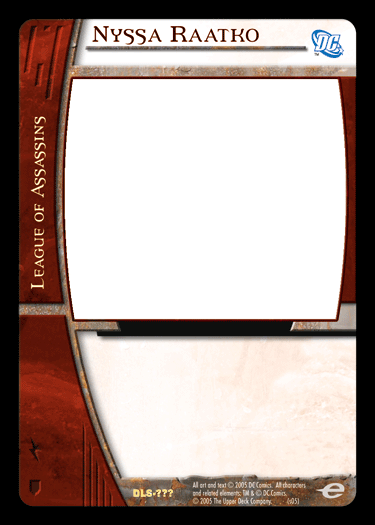
Fan Card Crossover – Week 1: Living Up to a Legacy
Fan Card Crossover – Week 2: In a League of Their Own
Current Card:

In what proved to be our closest week of polling for the Fan Card Crossover ever, the art description handed in by Ryan Hartman has closely edged out Gregory Rowbotham’s fine entry. Ryan wins four foil versions of Nyssa when she is printed in the Legion of Super-Heroes expansion at the end of the year!
I’ll now reveal the finalists from last week’s competition and how they did in the voting. Greg’s entry was tremendously close to taking the vote. You can even see that Metagame.com’s own Rian Fike made it to the final five.
- Ryan Hartman – 26.6%
- Gregory Rowbotham – 24.4%
- Mike Mullins – 20.9%
- Rian Fike – 17.4%
- Jeffery Petty – 10.7%
Here is the winning description:
Nyssa Raatko
Character Image
Setting: A steamy, vapor-filled room with a boiling Lazarus Pit possibly in the background.
Action: A dramatic foreground pose showing Nyssa cradling her sister, Talia, staring at what would be the viewer. Talia has a tortured look on her face—she has been repeatedly killed by Nyssa and revived via the Lazarus Pit. Nyssa’s knife should be prominent in the picture.
Focus: Nyssa’s face.
Color Focus: The reddish hue of Nyssa’s personal Lazarus Pit should put a tint on everything.
Keywords: Protective. Manipulative. Seductive.
Now that we have chosen most of the cosmetic aspects of your card, it’s time to get your hands dirty in the actual game-related mechanics. This week’s design tutorial will look into choosing what resource point cost Nyssa should be, and how we look at a team’s strengths and weaknesses in that context.
Like all TCGs, Vs. is fundamentally a resource management game, where exploiting your resources (i.e., resource points, cards, and endurance) to the fullest degree lets you attain supremacy over your opponent. So when we look at a team’s weaknesses, we often turn to how many resources that team is bringing out, and at what cost. In the early history of the game, decks that contained Dr. Doom, Diabolic Genius and Sabretooth, Feral Rage dominated the fourth turn, as they gave vastly superior returns. This is less likely to happen now, since Vs. currently encompasses off-curve strategies that seek to maximize their advantages in other ways. But since League of Assassins is first and foremost a curve deck (that is, a deck that seeks to put out one character using the full number of resource points available), we should look at when they are at their weakest.
I’m not going to show all the available characters, but rather, we’re going to look at the ones that have seen the most play so far:
1-drops: Josef Witschi, Malaq, Thuggee
2-drops: Talia, Daughter of the Demon’s Head, Bronze Tiger, Benjamin Turner, Hassim
3-drops: Hook, Kyle Abbot, Demon’s Hound, Ubu, Ra’s al Ghul’s Bodyguard
4-drops: Ra’s al Ghul, Eternal Nemesis, Ra’s al Ghul, Immortal Villain, Merlyn, Deadly Archer
5-drops: Lady Shiva, The Destroyer, Ubu, One of Many, Bane, Ubu
6-drops: Merlyn, Archer Assassin, Ra’s al Ghul, Master Swordsman
7-drops: Lady Shiva, Master Assassin, Ra’s al Ghul, Undying
8-drops: Ra’s al Ghul, The Demon’s Head
Looking at this lineup, it becomes clearer that League has some issues during drops 1–3 as well as at 6. The strongest area of the League curve is at four resources, where Ra’s al Ghul, Eternal Nemesis and Merlyn, Deadly Archer are very reasonable drops. It’s not that any of these drops are particularly bad—it’s simply that the depth of the team requires fleshing out.
A canny player should look behind the drops, keeping an eye out for redundancies in the strategies that the League pursues. League of Assassins has three primary strategies: counting stunned characters, manipulating locations, and direct KO’ing of the opponent’s characters. The list above demonstrates the key issue with building League decks—there is nearly always only one drop for each strategy option, which means that if the deck doesn’t hit its primary characters, it will often drop a card that serves no purpose beyond its ATK and DEF values. It’s also important to note that late League drops are usually played because of their stats, while early drops tend to have more powerful effects.
Now that we are armed with this information, we need to decide which general direction we would like to take with our card. This week, I am going to give you two elements to vote on: the resource cost and the card’s thematic direction.
What Cost?
1–8
What League theme?
· Keeping and counting stunned characters
· KO’ing characters directly
· Manipulating locations
· Plague counters
· Removing team affiliations
To vote, email fancardcrossover@gmail.com with your name and UDE number (if you have one). Then, put your choices in the header of the email. It’s time to make your voice heard!
Join me next week, when we look into team themes and how to design cards from every direction.
Good gaming,
TBS